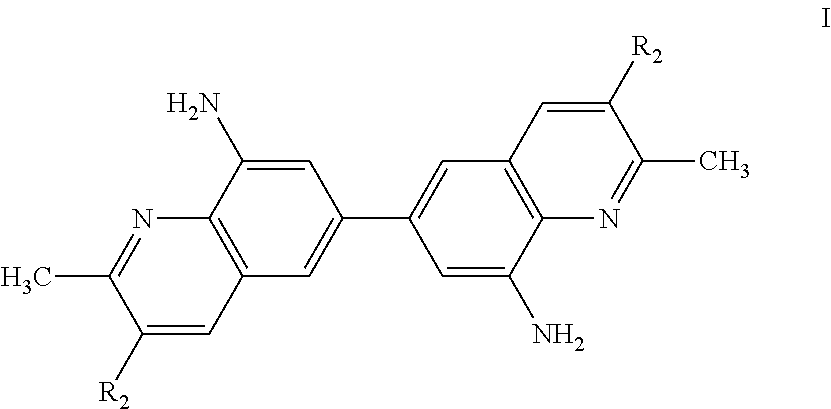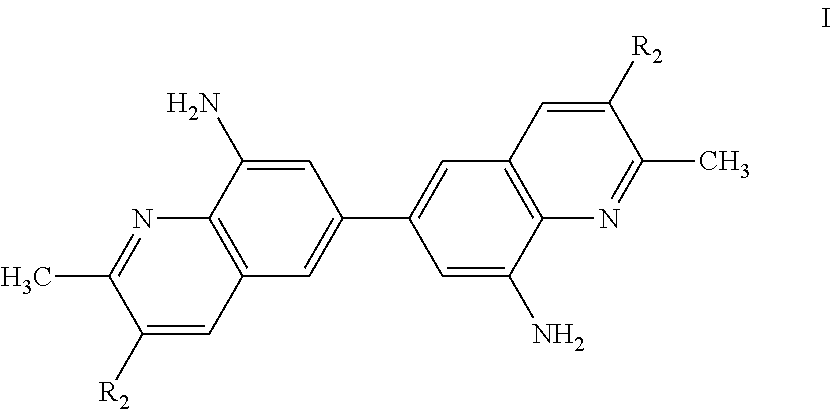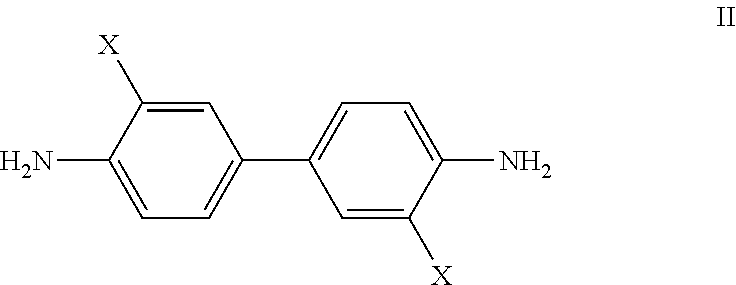Bis-quinaldine compound and a process for preparing the same
a technology of bis-quinophthalone and compound, applied in the field of bis-quinophthalone, can solve the problems of color fading, poor light resistance, mono-quinophthalone and bis-quinophthalon
- Summary
- Abstract
- Description
- Claims
- Application Information
AI Technical Summary
Benefits of technology
Problems solved by technology
Method used
Image
Examples
example 1
Preparation of Bis-8-amino quinaldine (8,8′-diamino-6,6′-bis-quinaldine)
Step 1: Preparation of Bis-8-chloro-quinaldine (8,8′-dichloro-6,6′-bis-quinaldine)
[0050]253 gm (1 mole) of 3,3′-dichlorobenzindine was added to 1610 gm (11.5 mol) of 70% (wt / wt) sulfuric acid solution and heated to 50° C. for 1 hour under stirring to obtain a mixture. To the resulting mixture, a solution of 7 gm of Sodium Iodide in 10 ml of water was slowly added and the mixture was heated to 100° C. for 1 hour. To this mixture, 247 gm crotonaldehyde (85%) was slowly added at 100° C. over a period of 3.5 hours. Scrubbing of the gas from condenser was maintained during addition. After addition the reaction mass was stirred at 101° C. for about 7 hours and further cooled to 50° C. The reaction mass was quenched by pouring on 5000 gm ice water while maintaining the temperature between 30° C. to 40° C. Subsequently, caustic lye was added to maintain the pH at 1.00. The reaction mass was filtered through hyflow bed a...
example 2
[0051]253 gm (1 mole) of 3,3′-dichlorobenzindine was added to 2100 gm (15 mol) of 70% (wt / wt) sulfuric acid solution and heated to 50° C. for 1 hour under stirring to obtain a mixture. To the resulting mixture, a solution of 7 gm of Sodium Iodide in 10 ml of water was slowly added and heated to 100° C. for 1 hour. To this solution, 247 gm crotonaldehyde (85%) was slowly added at 100° C. over a period of 3.5 hours. Scrubbing of the gas from condenser was maintained during addition. After addition the reaction mass was stirred at 101° C. for about 7 hours and cooled to 50° C. The reaction mass was quenched by pouring on 5000 gm ice water while maintaining the temperature between 30° C. to 40° C. Subsequently, caustic lye was added to maintain the pH at 1.00. The reaction mass was filtered through hyflow bed and washed with water. The mother liquor obtained was neutralized by caustic lye and filtered. The cake so obtained was washed with hot water and dried to yield Bis-8-chloro-quinal...
example 3
[0052]253 gm of 3,3′-dichlorobenzindine was added to 1610 gm of 70% (wt / wt) sulfuric acid solution and heated to 50° C. for 1 hour under stirring to obtain a mixture. To the resulting mixture, a solution of 7 gm of Sodium Iodide in 10 ml of water was slowly added and heated to 80° C. for 1 hour. To this solution, 247 gm crotonaldehyde (85%) was slowly added at 80° C. over a period of 3.5 hours. Scrubbing of the gas from condenser was maintained during addition. After completion of addition the reaction mass was stirred at 80° C. for about 7 hours and cooled to 50° C. The reaction mass was quenched by pouring on 5000 gm ice water while maintaining the temperature between 30° C. to 40° C. Subsequently, caustic lye was added to maintain the pH at 1.00. The reaction mass was filtered through hyflow bed and washed with water. The mother liquor obtained was neutralized by caustic lye and filtered. The cake so obtained was washed with hot water and dried to yield Bis-8-chloro-quinaldine (2...
PUM
| Property | Measurement | Unit |
|---|---|---|
| temperature | aaaaa | aaaaa |
| temperature | aaaaa | aaaaa |
| temperature | aaaaa | aaaaa |
Abstract
Description
Claims
Application Information
 Login to View More
Login to View More - R&D
- Intellectual Property
- Life Sciences
- Materials
- Tech Scout
- Unparalleled Data Quality
- Higher Quality Content
- 60% Fewer Hallucinations
Browse by: Latest US Patents, China's latest patents, Technical Efficacy Thesaurus, Application Domain, Technology Topic, Popular Technical Reports.
© 2025 PatSnap. All rights reserved.Legal|Privacy policy|Modern Slavery Act Transparency Statement|Sitemap|About US| Contact US: help@patsnap.com



